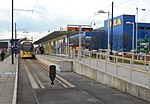Rock Mill, Ashton-under-Lyne
Buildings and structures demolished in 1971Buildings and structures in Ashton-under-LyneDemolished buildings and structures in Greater ManchesterTextile mills in TamesideTextile mills owned by the Lancashire Cotton Corporation
Rock Mill was cotton spinning mill in the Waterloo district of Ashton-under-Lyne, Greater Manchester, in England. It was built between 1891 and 1893 for the Ashton Syndicate by Sydney Stott of Oldham. Rock Mill was built on the site of Wilshaw Mill retaining and using the octagonal chimney. It ceased spinning cotton in the 1960s and was demolished in 1971; the site became the location for the town's first Asda supermarket, which opened in 1972, until Asda relocated to a much larger new store site in Cavendish Street in 1989.
Excerpt from the Wikipedia article Rock Mill, Ashton-under-Lyne (License: CC BY-SA 3.0, Authors).Rock Mill, Ashton-under-Lyne
Langham Street, Tameside Taunton
Geographical coordinates (GPS) Address Nearby Places Show on map
Geographical coordinates (GPS)
| Latitude | Longitude |
|---|---|
| N 53.4983 ° | E -2.102 ° |
Address
Langham Street
Langham Street
OL7 9AJ Tameside, Taunton
England, United Kingdom
Open on Google Maps






